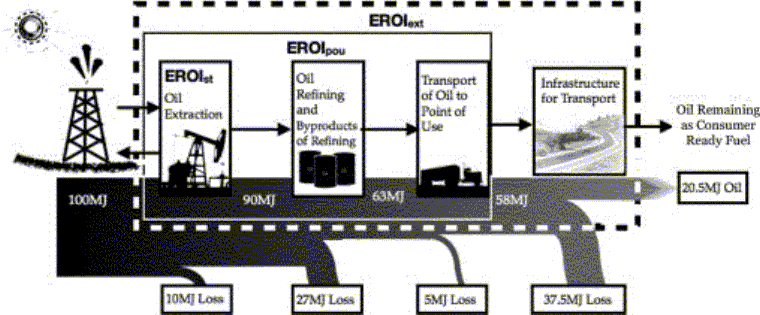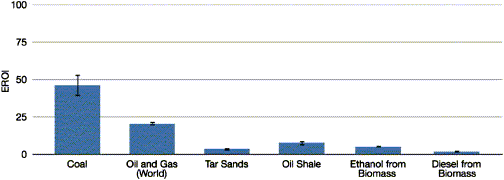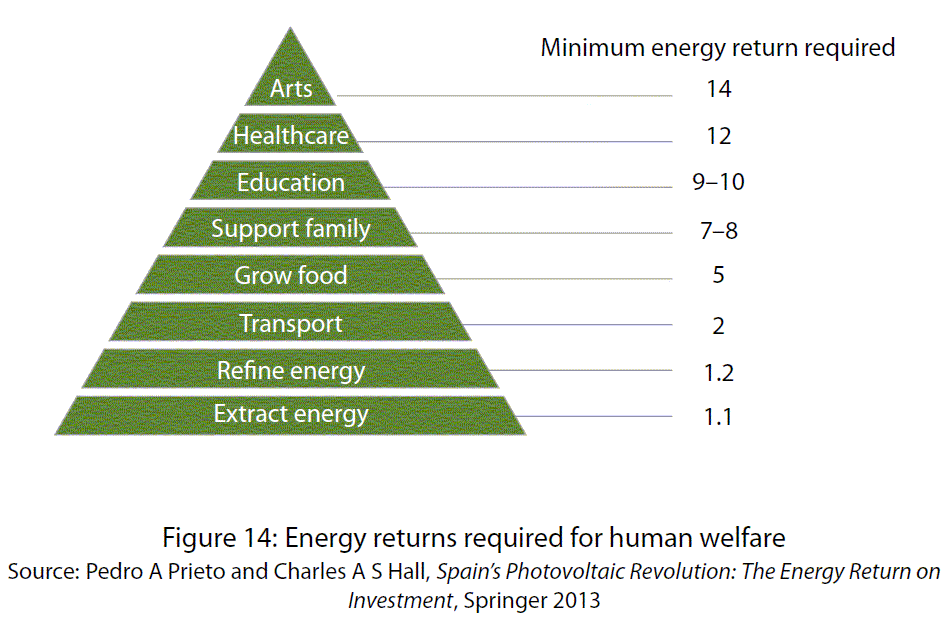EROI

Fossil Fuels are suffering from diminishing returns. All the ‘low hanging fruit’ has been picked.
There are two tyoes of EROI; energy return on energy invested and energy return on financial investment
In the early days of steam power it was noted;
A coalminer who consumes in his own body about 3,500 Calories a day will, if he mines 500 pounds of coal, produce coal with a heat value 500 times the heat value of the food which he consumed while mining it. At 20 per cent efficiency he expends about 1 horsepowerhour of mechanical energy to get the coal. Now, if the coal he mines is burned in a steam engine of even 1 per cent efficiency it will yield about 27 horsepower-hours of mechanical energy. The surplus of mechanical energy gained would thus be 26 horsepower-hours, or the equivalent of 26 man-days per man-day.
So in this case the energy return on investment was 27 fold.
The best coal mines were generally assumed to be 100:1 return, these days 46:1 is the international mean.
World oil and gas has a mean EROI of about 20:1 The EROI for the production of oil and gas globally by publicly traded companies has declined from 30:1 in 1995 to about 18:1 in 2006. Alternatives to traditional fossil fuels such as tar sands and oil shale deliver a lower EROI, having a mean EROI of 4:1
Of course below 2:1 is usually the give up and go home point.
Nuclear power is not extra special, I think this is eroi($)

Four out of the five recessions experienced since 1970 can be explained by examining oil price shocks. During periods of recession, oil prices tend to decline, eventually encouraging increased consumption. Alternatively, during periods of expansion, oil prices usually increase and higher energy consumption and economic expansion are eventually constrained by these higher prices. Economic growth and stability is dependent on not only the total quantity of energy accessible to society but also the cost of this energy to different sectors of that society. The ratio of the monetary cost of energy compared to the GDP generated for the same year gives a quantitative index of how much money is invested in energy on average to generate a unit of wealth. This can be calculated by dividing the money required to buy energy by the total gross domestic product. When this ratio is low, typically around five percent, economies grow strongly. When this ratio is high, about ten percent (and, historically, up to fourteen percent), recessions tend to occur. From EROI of different fuels and the implications for society Charles A.S. Hall Jessica G. Lambert Stephen B. Balogh
We have all heard of money laundering, but have you heard of Carbon Laundering with Green Wash?
DRAX is king of carbon laundering, but more locally
In 2018 Scion was proud of their ‘drop in’ biomass derived diesel replacement research, note the eroi in this chart

Natures Flame use 1J of geothermal energy (as well as electricity and maybe gas) for every 3J of wood pellets they produce
Energy laundering, like making money through financial instruments is morally corrupt, ultimately it impoverishes society.





